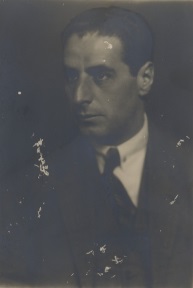Ernst Toch facts for kids
Ernst Toch (born December 7, 1887 – died October 1, 1964) was an Austrian composer. He wrote many kinds of classical music and also music for movies. Throughout his life, he always looked for new and exciting ways to create music.
A Young Musician's Life
Ernst Toch was born in Leopoldstadt, a part of Vienna, Austria. His family was Jewish, and his father was a leather dealer. Vienna was a very important city for culture and arts when he was growing up.
Education and Early Career
Ernst studied many subjects, not just music! He studied philosophy at the University of Vienna and medicine at Heidelberg. But his real passion was music, which he studied at the Hoch Conservatory in Frankfurt from 1909 to 1913.
His main instrument was the piano. He was a very talented pianist and performed all over Europe. Many of his early musical pieces were written for the piano.
Becoming a Full-Time Composer
Ernst Toch started composing music around 1900. His first pieces were similar to the style of Mozart. In 1908, one of his first string quartets was played in Leipzig.
He won the Frankfurt/Main Mozart prize in 1909 for his Chamber Symphony in F major. After this, Toch decided to become a full-time composer. He won the Mendelssohn prize for composition in 1910.
In 1913, he started teaching piano and composition at the College of Music in Mannheim. He won five more big awards for his music.
World War I and Marriage
During World War I, Ernst Toch served in the army for four years on the Italian Front. In 1916, he married Lilly Zwack, whose father was a banker.
After the war, he went back to Mannheim to compose. He started to develop a new style of music called polyphony. This is when several independent melodies are played at the same time. In 1921, he earned his Ph.D. degree from Heidelberg University. He also taught at the Mannheim Conservatory.
Life in Exile
In 1933, when Adolf Hitler came to power, Toch had to leave Germany because he was Jewish. He first went to Paris and then to London. In London, he started writing music for movies.
Moving to America
In 1935, Ernst Toch was invited to come to New York City. He later moved to California. There, he wrote music for Hollywood movies to make a living. However, he was not as famous in the film industry as some other composers.
One of his most well-known pieces of film music is for the chase scene in Shirley Temple's 1937 movie, Heidi.
Teaching and Later Works
While living in California, Toch became a professor at the University of Southern California. He taught both music and philosophy. He also taught as a guest lecturer at Harvard University.
He wrote a book about music theory called The Shaping Forces in Music (1948). From 1950 onwards, he composed seven symphonies. His Third Symphony (Opus 75, 1954) won the famous Pulitzer Prize three years later. In these later works, his style became more like the Romantic music he wrote when he was younger.
In 1958, he received a high honor from Germany, the Order of Merit of the Federal Republic of Germany.
Ernst Toch passed away in Santa Monica, California, in 1964. He is buried in the Westwood Village Memorial Park Cemetery in Los Angeles. His grandchildren are the authors Lawrence Weschler and Toni Weschler.
Toch's Musical Creations
Ernst Toch's music often had a funny side, like in his Bunte Suite (1929). In 1930, he created "Gesprochene Musik," which means "spoken music." This involved a chorus speaking words rhythmically instead of singing.
His most famous piece is the Geographical Fugue, also known as Fuge aus der Geographie. It's a fun piece where a chorus speaks the names of cities and countries in a musical way. Even though it's very popular, he thought it was just a small, fun project.
He wrote many different types of music, including:
- Music for films
- Symphonies (large pieces for orchestra)
- Chamber music (for small groups of instruments)
- Chamber operas (short operas)
He also wrote books about music theory, like Melodielehre (1923) and The Shaping Forces in Music (1948).
Before the Nazi era, Toch was seen as one of the most important modern composers. He won the Pulitzer Prize for Music in 1956 for his Third Symphony. It was first performed by the Pittsburgh Symphony Orchestra in 1955.
Some of His Works
Ernst Toch composed a wide range of musical pieces. Here are some examples from different categories:
Symphonies
- Symphony No. 1, Op. 72 (1950)
- Symphony No. 3, Op. 75 (1955) – This one won the Pulitzer Prize!
- Symphony No. 5 ‘Jephtha, Rhapsodic Poem’, Op. 89 (1963)
Concertos
- Concerto for Cello and Chamber Orchestra, Op. 35 (1924)
- Concerto for Piano and Orchestra, Op. 38 (1926)
Other Orchestral Works
- Bunte Suite (Motley Suite), Op. 48 (1928)
- Pinocchio: A Merry Overture for Orchestra (1935)
- Circus: An Overture, for orchestra (1953)
Chamber Music
- String Quartet no. 9 in C major, Op. 26 (1919)
- Sonata for Cello and Piano, Op. 50 (1929)
- Quintet for Piano, Two Violins, Viola and Cello, Op. 64 (1938)
Piano Music
- Burlesken (Burlesques), Op. 31 (1923)
- Kleinstadtbilder (Echoes From a Small Town), Op. 49 (1929)
- Reflections, Op. 86 (1962)
Operas
- Die Prinzessin auf der Erbse [The Princess and the Pea], Op. 43 (1927)
- Der Fächer [The Fan], Op. 51 (1929 or 1930)
Choral Works
- Gesprochene Musik (Speaking Music), (1930)
- Geographical Fugue, for speaking chorus (1930) – His most famous piece!
Film Music
- Catherine the Great (1933)
- Heidi (1937) – He wrote the music for the famous chase scene!
- The Cat and the Canary (1939)
See also
 In Spanish: Ernst Toch para niños
In Spanish: Ernst Toch para niños


